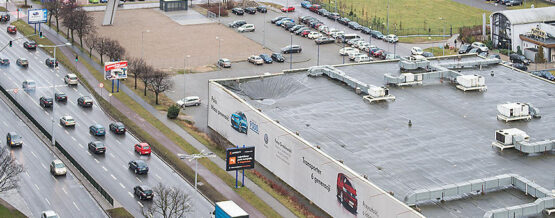Heavy rainfall surprises us more and more seldom. One might be tempted to say that they have settled in Poland for good. Therefore, one should remember that intensive rains are dangerous. All the more so if it rains suddenly. Then, the failure of a flat roof may be serious. The employees of Eko-Okna in Kornice found that out. A sudden cloudburst and an hourly rainfall of up to 60 mm led to the collapse of the roof of production hall no. 6. As reported by the employees of Eko-Okna, they suddenly saw the roof bulging and ran away from the facility. A moment later, the roof collapsed under the pressure of water, which started to pour into the hall in streams. Fortunately, no one was hurt. The problem, however, is the financial loss, initially estimated at 250,000 PLN, and the forced stoppage of operations of the hall.
How to avoid such accidents?
CAUSES OF A FLAT ROOF COLLAPSE
The most common cause of such serious events as flat roof failure (e.g., roof collapse) is the obstruction of roof drains. Even a small obstruction of one of the gullies may become a big problem in case of intensive or long-lasting rainfall. In order to prevent water from accumulating on the flat surface, it should be systematically and effectively drained off. The increasing amount of water every minute puts more and more strain on the building structure.
Obstructed drains are also the reason for water ponding. After rainfall has stopped, the water on the roof of a production hall, warehouse or shopping centre has a negative impact on the building structure. Even if there is no fatal roof collapse, the structure may be permanently damaged.
WHERE DO FLAT ROOF FAILURES COME FROM?
The owners of large-size facilities are obliged to properly take care of the condition of the roof. This means, first of all, regular technical inspections. Regulations require (due to the Polish Journal of Laws of 2007, No. 99, item 665) that such inspections take place every six months and are performed by an authorized constructor.
There can be three consequences of failing to inspect a flat roof. The first one is a financial penalty: if the inspector finds out that the entries in the building book are missing, he will certainly not only oblige the owner of the building to make up for the missing entries, but also impose a sanction in the form of a high fee. The second consequence is the difficulty in paying the insurance. If there is a roof failure but the insurer can show that the building has not been operated properly – they will have strong grounds to dismiss the claim. The third cause of negligence is a building catastrophe. This is the most tragic, as it threatens the health or lives of workers. Not to mention, of course, the destruction of machinery and goods, or the forced stoppage of work, which generates serious costs.
Therefore, owners of production halls, logistics centres, public buildings and other large-area facilities should prepare for heavy rain. The Water Level Sensors (DSW) will help. This is a proprietary system developed by Sense Monitoring engineers to eliminate events such as flat roof failure.
PRECIPITATION FINALLY UNDER CONTROL
The main functionality of DSW boils down to precise monitoring of the amount of water on a flat roof. The system flawlessly detects abnormal water levels. At the same time, it provides reliable knowledge about the patency of gullies and the duration of stagnation of water in their vicinity. Thanks to the current verification of the amount of water on the roof, DSW informs of the danger of too much water lying on the roof. As a result, the risk of overloading the structure due to accumulated water is minimised. In addition, the risk of leaks caused by prolonged stagnation is also significantly reduced.
The information provided by the DSW enables immediate action to be taken in emergency situations. Any exceedance of safe levels is immediately recorded. Users of the Intelligent Roof Platform receive this information via SMS and e-mail.
BENEFITS OF DAILY DSW USE
But Water Level Sensors also work well for the daily use of the building. The solution allows the technical services to check the correct roof drainage and the patency of the gullies without having to go to the roof. As a result, the DSW increases the durability of the roofing and the roof structure.
Finally, the DSW user no longer has to worry about technical inspections. The data on the performance of the gullies comes to him automatically, allowing him to complete the building book. The use of the DSW will also be an indisputable proof for the insurer that the owner of a hall or a production plant has taken full care of his facility. He has reduced the probability of events such as flat roof failures to a minimum.
The Water Level Sensors are part of the Smart Roof Platform, which also includes Sense S-One deflection monitoring. The platform has gained the recognition of many customers – it currently protects more than 900,000 m2 of flat roofs.
If you, too, are concerned about the safety of your employees and equipment. If you, too, would like peace of mind during the most torrential downpour, choose Water Level Sensors for your flat roof. Contact us and we will answer your questions. We would be happy to go on a site visit to tell you what a DSW installation would look like on your property.






